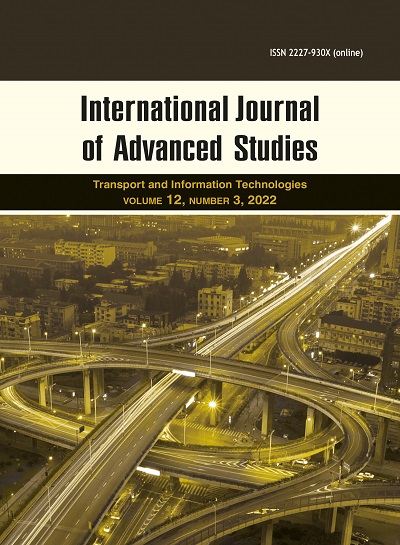ИССЛЕДОВАНИЕ ВЛИЯНИЯ ПРОПУСКА ТЯЖЕЛОВЕСНЫХ ПОЕЗДОВ НА ПРОПУСКНУЮ И ПРОВОЗНУЮ СПОСОБНОСТИ ЖЕЛЕЗНОДОРОЖНЫХ УЧАСТКОВ ПРИ ЭЛЕКТРИЧЕСКОЙ ТЯГЕ
Аннотация
Критерием эффективности организации тяжеловесного движения на участках сети железных дорог России является наличие крупных корреспонденций массовых грузов, предъявляемых грузоотправителем к перевозке. Препятствием к освоению перспективного грузопотока становятся участки с ограниченной пропускной и провозной способностями, преодолением которого выступает организация тяжеловесного движения. Все страны, которые имеют железные дороги, на определенном этапе развития сталкиваются с ограничениями пропускной способности. Обобщая мировой опыт можно сделать вывод, что приоритетом в освоении возрастающих объемов «тяжелых грузов» становится повышение весовых норм грузовых поездов. Проблема пропуска тяжеловесных поездов для Российских железных дорог является актуальной, вследствие того, что пропускные способности некоторых участков исчерпали себя полностью. Весьма своевременное появление тяжеловесного движения становится одним из вариантов решения проблемы повышения провозных способностей участков и направлений и, как следствие, создание резерва пропускной способности. В данной статье выполнено исследование влияния их движения на пропускную и провозную способности.
Скачивания
Литература
References
Kuz’mina N.A. Sbornik nauchnykh trudov Evraziyskogo Nauchnogo Obedineniya, 2020, no. 1(59), pp. 45-50.
Harris W.J., Zakharov S.M. et al. Obobshchenie peredovogo opyta tyazhelovesnogo dvizheniya [Generalization of the advanced experience of heavy haul traffic: issues of wheel and rail interaction]. M.: Intekst, 2002, 408 p.
Martins. R. S. Costa R. J. Wheel and Rail Performance at Carajas Railway. Guidelines to Best Practices for Heavy Haul Operations: Wheel and Rail Interface Issues, IHHA, Virginia Beach, USA, 2001, pp. 4.25-4.27.
Roney M Maintaining Technical Leadership in Today’s Business Environment. Proceedings of 7th IHHA Conference. Brisbane, Australia, 2001, pp. 1-2.
Zhixiu Geng. Heavy-haul Transportation Technologies on Datong-Qinhuangdao Railway. China Railway Publishing House, Beijing, 2009. 539 p.
Abhyuday D.R. Cost reduction policies and driving behaviour. Ir train drivers influencing diesel traction energy consumption. Novye tendentsii razvitiya v upravlenii protsessami perevozok, avtomatike i infokommunikatsiyakh: Tr. Vseros. nauch.-prakt. konf. uchenykh transp. vuzov, inzhenernykh rabotnikov i predstaviteley akademicheskoy nauki s mezhdunarodnym uchastiem (Khabarovsk, 29 sentyabrya 2017 g.) [New development trends in the management of transportation processes, automation and infocommunications: Tr. Vseros. scientific-practical. conf. scientists transp. universities, engineering workers and representatives of academic science with international participation (Khabarovsk, September 29, 2017)] / ed. A.I. Godyaev. Khabarovsk: Izd-vo DVGUPS, 2017, pp. 19−35.
Rules for the technical operation of the railways of the Russian Federation. URL: https://company.rzd.ru
“Program for the development of heavy-haul traffic on the railway network of Russian Railways”. URL: http://www.rzd-expo.ru/images/Events-2019/27ts/01.pdf
Development strategy of the Russian Railways holding for the period up to 2030 (basic provisions). URL: http://doc.rzd.ru/doc/public/ru?STRUCTURE_ID=704&layer_ id=5104&id=6396
Klimova E. V. Vestnik Sibirskogo gosudarstvennogo universiteta putey soobshcheniya, 2017, no. 4 (43), pp. 66–73.
Gil’manov A.I., Zalogova O.I. Molodaya nauka Sibiri, 2018, no. 1. http://mnv.irgups.ru/toma/11-2018
Ushkova E. RZhD PARTNER, 2018, no. 9(373), pp. 59-61.
Список литературы
Кузьмина Н.А. Исследование влияния движения поездов повышенной массы и длины как элемента увеличения эффективности перевозочного процесса // Сборник научных трудов Евразийского Научного Объединения. 2020. № 1(59). С. 45-50.
Обобщение передового опыта тяжеловесного движения: вопросы взаимодействия колеса и рельса: пер. с англ./ У. Дж. Харрис, С.М. Захаров [и др.]. М.: Интекст, 2002. 408 с.
Martins. R. S. Costa R. J. Wheel and Rail Performance at Carajas Railway // Guidelines to Best Practices for Heavy Haul Operations: Wheel and Rail Interface Issues, IHHA, Virginia Beach, USA, 2001. pp. 4.25-4.27.
Roney M Maintaining Technical Leadership in Today’s Business Environment // Proceedings of 7th IHHA Conference. Brisbane, Australia, 2001, pp. 1-2.
Zhixiu Geng. Heavy-haul Transportation Technologies on Datong-Qinhuangdao Railway. China Railway Publishing House, Beijing, 2009. 539 p.
Abhyuday D.R. Cost reduction policies and driving behaviour. Ir train drivers influencing diesel traction energy consumption // Новые тенденции развития в управлении процессами перевозок, автоматике и инфокоммуникациях: Тр. Всерос. науч.-практ. конф. ученых трансп. вузов, инженерных работников и представителей академической науки с международным участием (Хабаровск, 29 сентября 2017 г.) / под. ред. А.И. Годяева. Хабаровск: Изд-во ДВГУПС, 2017. С. 19−35.
Правила технической эксплуатации железных дорог Российской Федерации: сайт. URL: https://company.rzd.ru (дата обращения: 12.09.2021).
«Программа развития на сети железных дорог ОАО «РЖД» тяжеловесного движения». URL: http://www.rzd-expo.ru/images/Events-2019/27ts/01.pdf (дата обращения: 11.08.2021).
Стратегия развития холдинга «РЖД» на период до 2030 года (основные положения) : дата офиц. опубл.: 16.04.2014 // ОАО «РЖД» : сайт. URL: http://doc.rzd.ru/doc/public/ru?STRUCTURE_ID=704&layer_ id=5104&id=6396 (дата обращения: 22.09.2021).
Климова Е. В. Исследование сфер эффективности применения технологии пропуска соединенных и тяжеловесных поездов // Вестник Сибирского государственного университета путей сообщения. 2017. № 4 (43). С. 66–73.
Гильманов А.И. Увеличение массы поезда по сети железных дорог [Электронный ресурс] / А. И. Гильманов, О. И. Залогова // Молодая наука Сибири: электрон. научн. журн. 2018. №1. http://mnv.irgups.ru/toma/11-2018
Ушкова Е. Тяжеловесам – зеленый свет // РЖД ПАРТНЕР. 2018. №9(373). С. 59-61.
Просмотров аннотации: 324
Copyright (c) 2022 Valentina V. Shirokova, Natalya A. Kuzmina, Tatyana A. Odudenko, Galina V. Sankova

Это произведение доступно по лицензии Creative Commons «Attribution-NonCommercial-NoDerivatives» («Атрибуция — Некоммерческое использование — Без производных произведений») 4.0 Всемирная.







































